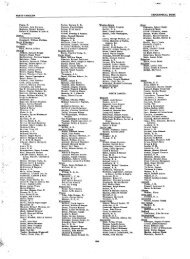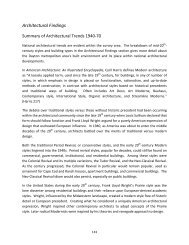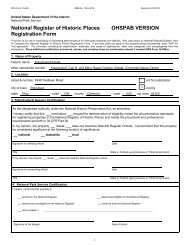national register of historic places registration form - Ohio Historical ...
national register of historic places registration form - Ohio Historical ...
national register of historic places registration form - Ohio Historical ...
Create successful ePaper yourself
Turn your PDF publications into a flip-book with our unique Google optimized e-Paper software.
NPS Form 10-900 OMB No. 1024-0018<br />
(Rev. 10-90)<br />
United States Department <strong>of</strong> the Interior<br />
National Park Service<br />
NATIONAL REGISTER OF HISTORIC PLACES<br />
CONTINUATION SHEET<br />
Section number 8 Page 14<br />
Eastwood Historic District<br />
Cincinnati, Hamilton County, <strong>Ohio</strong><br />
Eastwood was a planned neighborhood which started as a 60-acre wood and farmland. Platted in<br />
1922, Eastwood Subdivision largely developed beginning in the 1930s and continued gradually<br />
through the early 1950s, during the time <strong>of</strong> the Great Depression, World War II and the post-war<br />
housing boom. As a result <strong>of</strong> the increased vehicular mobility and access <strong>of</strong>fered by automobiles and<br />
buses, suburban development began to fill in Cincinnati’s larger undeveloped, pre-suburban tracts.<br />
Eastwood was able to develop as a modest, tightly-knit middle-class residential enclave despite hard<br />
economic times because <strong>of</strong> its proximity to relatively stable Cincinnati industries, notably Cincinnati<br />
Milling Machine, the nation’s largest machine tool manufacturer. Eastwood’s housing development<br />
during the 1940s reflects the relatively dependable growth <strong>of</strong> nearby industries, many <strong>of</strong> which<br />
operated at peak capacity during WW II and after. Of the 34 occupations listed in the city directories<br />
for property owners during the 1930s, 28 were identified as managers or pr<strong>of</strong>essionals.<br />
Original plats show Eastwood Subdivision #1 platted by the Eastwood Realty Co. This is now East<br />
and West Eastwood Circle and part <strong>of</strong> Madison and Duck Creek Roads. The deed records <strong>of</strong><br />
Hamilton County show Eastwood #2 and Eastwood #3 as Collinwood Place and part <strong>of</strong> Madison<br />
Road, and Overbrook Place and part <strong>of</strong> Duck Creek Road, respectively. There were 30 acres sold<br />
from the estate <strong>of</strong> Phoebe A. Settle (an original Madisonville family) to A. Raymond and Alice G.<br />
Kratz on 8/17/22. The Settles had had a farm here with a farmhouse next to the Children’s Home. On<br />
9/1/22 the Kratz’ began to have the land surveyed into the plats that still exist in what seems to be the<br />
same <strong>form</strong> today. Mr. Kratz is listed in the1920 city directory as a music teacher living on Woodburn<br />
Av. and in the 1929-30 directory as a teacher at Hughes High School and as living on Erie Avenue.<br />
Kratz’s obituary indicates he was a well-known music teacher and supervisor, bandmaster and author<br />
<strong>of</strong> teaching guides. His brothers were doctors, one <strong>of</strong> whom was J. Collin Kratz, who owned the<br />
house at 4900 Madison Road and for whom Collinwood is named. In his house today exists the<br />
original sign he used to sell the rest <strong>of</strong> the lots <strong>of</strong> the street <strong>of</strong> Collinwood. It advertises them for<br />
$95.00 each. Dr. J.C. Kratz was a prominent citizen <strong>of</strong> Cincinnati. He founded an osteopathic<br />
hospital. He was a close friend to many in the local political scene and an active supporter <strong>of</strong> the<br />
symphony and the fine arts. He was a writer as well as the developer <strong>of</strong> many landmark medical<br />
techniques. His wife Minnie Kratz was a member <strong>of</strong> the Vanderhortz family who built many area<br />
church steeples. They had a sign hanging during the Depression to indicate to hobos that they could<br />
receive a free meal at their house. The father <strong>of</strong> these men, William.H. Kratz (a mechano-therapist),<br />
owned the house at 5031 West Eastwood Circle. Plat copy shows G. L. Stichnath as the surveyor.<br />
There is interestingly enough a survey tool found in the corner <strong>of</strong> the attic <strong>of</strong> 5049 W. Eastwood Circle<br />
(a house that is said once belonged to the original builder). The oldest houses are mainly on<br />
Collinwood; and on the circle the middle, outside <strong>of</strong> the circle was built first. The center stayed empty<br />
the longest because Ray Kratz, the developer, kept these lots for himself yet never built there.






